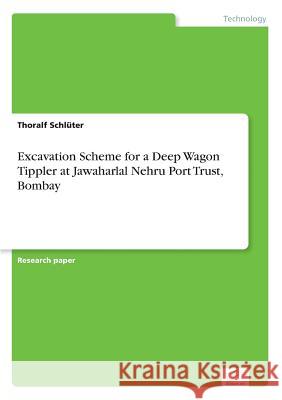Excavation Scheme for a Deep Wagon Tippler at Jawaharlal Nehru Port Trust, Bombay » książka
Excavation Scheme for a Deep Wagon Tippler at Jawaharlal Nehru Port Trust, Bombay
ISBN-13: 9783838687568 / Angielski / Miękka / 2005 / 128 str.
Excavation Scheme for a Deep Wagon Tippler at Jawaharlal Nehru Port Trust, Bombay
ISBN-13: 9783838687568 / Angielski / Miękka / 2005 / 128 str.
(netto: 411,94 VAT: 5%)
Najniższa cena z 30 dni: 429,00
ok. 16-18 dni roboczych
Bez gwarancji dostawy przed świętami
Darmowa dostawa!
Scholarly Research Paper from the year 2000 in the subject Engineering - Civil Engineering, grade: 1,3, Hamburg University of Technology (Bauingenieurwesen und Umwelttechnik), language: English, abstract: Inhaltsangabe: Introduction: The Jawaharlal Nehru Port Trust, called JNPT, is situated close to Mumbai (former name Bombay) at the same channel used by Mumbai Port and Jawahar Dweep Oil Terminal. It is the youngest and most modern port of India. Commissioned in May 1989, the port still has high development ambitions especially in the sector of expansion, which is necessary in view of its purpose of decongesting Mumbai Port and the serving as a Hub Port for this region. The new Nhava Sheva Container Terminal Project is an example for the continuous progress in realising these plans. In carrying out of these plans, structures like deep wagon tippler are required for managing bulk cargoes at the bulk terminals. This type of structure allows an economical unloading of cargoes from trains. Because of the necessary depth of a wagon tippler the cargoes have to surmount a difference in altitude of about 12 m from ground level and additional the difference in altitude from ground level up to the vessel. This can only be done by using long conveyor tunnels. An elevation of the cross section for a typical deep wagon tippler, borrowed from an existing structure. In the first part of this project work, a review on different, often used schemes, for deep excavations is done to find out a favourable excavation scheme for construction of a deep wagon tippler. The choice for a structure using RCC diaphragm walls as retaining walls is based on its merits under the existing soil conditions and on a possible serving as part of the final structure. During a site visit to JNPT the decision for this type of excavation scheme was discussed with site engineers, who have experience in constructing RCC diaphragm walls under existing soil and groundwater conditions. Finally an analysis of a t











